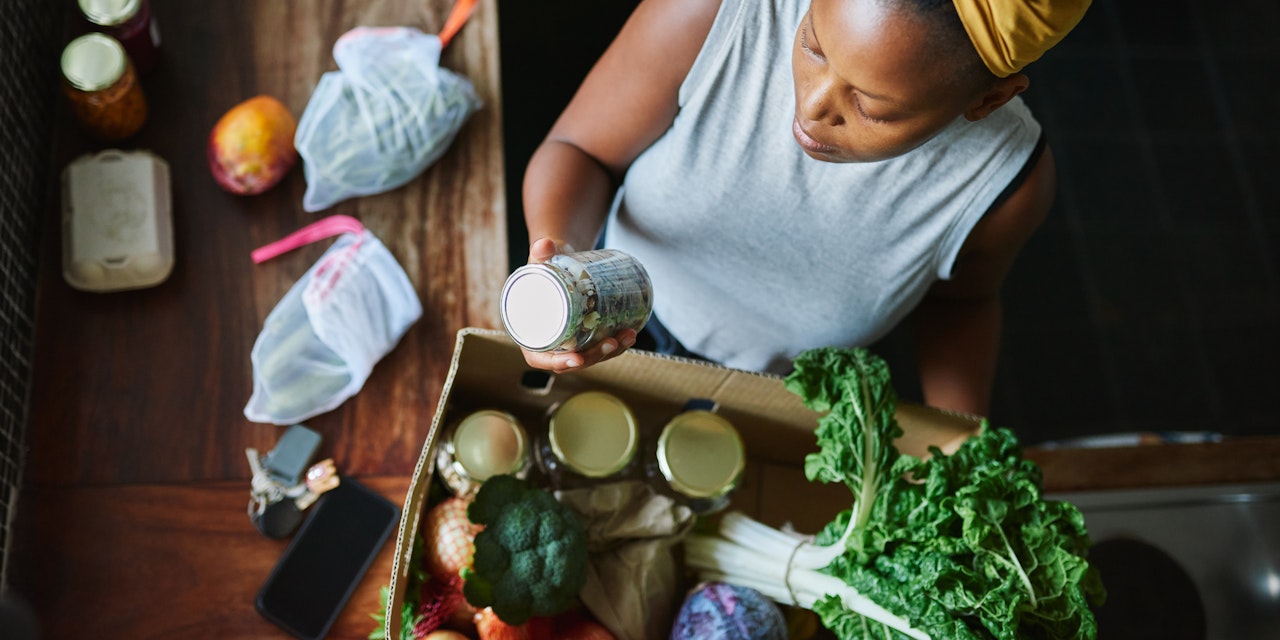Healthy Food Shopping: 6 Tips to Set You up for Success
Preparing yourself for a supermarket trip can set the stage for success. Learn staple foods to keep at home and shopping tips to stop impulse buys.
- Published: 2/11/2021
- Categories:
- 4 min. read

- Published: 2/11/2021
- Categories:
- 4 min. read
Arriving at the grocery store after a long day, feeling famished and exhausted is a recipe for…. “Oh hello there candy!”
Grocery shopping can be stressful and tempting even for the most organized and health conscious. Properly preparing yourself for a smooth supermarket trip can set the stage for success. Learn staple foods to keep at home and shopping tips to stop those unintended impulse buys.
6 tips for healthy shopping
Healthy eating is much easier if you plan ahead. With these six tips for healthy shopping, you can pass on the pressure to purchase unhealthy and unnecessary foods and focus on filling your bags with healthy options instead.
Plan and prepare
Prevent those impulsive purchases by planning your meals in advance versus wandering around the aisles being tempted by all the bright colors and deals on items you don’t necessarily need. You’ll also reduce food waste which also helps you save money. When you buy foods that you don't need, there’s an increased chance that the food will spoil.
Lifesum creates a personalized shopping list, based off of your meal plan!
Prioritize the perimeter
Grocery stores stock the fresh stuff on the outskirts of the store. This is typically where fruits, vegetables, dairy, meat and whole grains are kept. So focus your attention and shopping energy on these areas.
Venture into the inner isles only when you know what you’re searching for. The inner isles are where you can find some healthy non-perishable staples, but it's easy to get distracted by the colorful boxes of craving laden foods.
Also use caution when you’re checking out. James Clear, author of Atomic Habits, explains that candy isn’t an item that you would necessarily have on your list. So the store strategically places it in a highly visible place: the checkout line.
If you saw candy at the beginning of your shopping trip, you’d be more likely to resist it. By the time you’re at the checkout, the number of choices you’ve had to make at the store has exhausted you, called decision fatigue. So you’re more willing to give into the craving (1).
Become a label detective
Some foods may seem healthy when they actually have hidden sources of added sugar, salt, fat, and/or preservatives. Learning how to read nutrition labels can help you distinguish the best option.
Health claims can sometimes be deceiving. These claims suggest the food has beneficial nutritional properties but they can lead consumers to view the product as healthy regardless of its possibly lacking nutrient content (2). To achieve optimal health, it's best to avoid foods that contain additives and preservatives (3).
Dig into diversity
Including a variety of foods is not only healthy, it's also important for keeping meals interesting. If you get bored of the same dish, you’re more likely to default to processed and packaged foods.
Choose a variety of colors and types of fruits and vegetables. This will increase the amount of vitamins and minerals you get. Colorful fruits and vegetables are also rich in phytonutrients which can help protect against certain diseases, support cell and skin health, and even prevent some of the natural wear and tear of the environment (4).
Research is inconclusive when it comes to whether or not eating organic has a significant benefit. Choosing a variety can also prevent an excess exposure to any one pesticide. Aim to incorporate a new fruit or vegetable every week.
Stock-up on pantry essentials
Healthy eating is all about making good choices, easy! When you have your kitchen stocked with healthy staples, you’ll be much more likely to build a well-rounded meal.
You won’t always be able to find fresh produce, especially when it’s out of season. So stock up on these healthy helpers:
Pantry:
- Canned vegetables without salt.
- Canned fruit without sugar.
- Canned fish (salmon, tuna)
- Canned beans without added salt or sugar
- Dry beans and lentils
- Dry wholegrains: pasta, quinoa, brown rice, beans, barley oats, crackers
Fridge:
- Lean fresh poultry
- Lean fresh beef
- Fish
- Eggs.
- Low-fat dairy
- Tofu
- Fresh fruits and vegetables
- Whole grain bread
Frozen:
- The above protein can also be stored frozen
- Fruit and vegetables without added salt or sugar
- Whole grain bread, pita, tortilla
Ready to prep recipes
This delicious and nutritious recipe can be tossed together in a jiffy with your stocked pantry staples. Feel free to substitute whatever vegetables you have at home. Don’t have bell pepper? No problem. Try spinach, cucumber, onion, and more!
Super simple recipe made from canned chickpeas and tuna with your choice of vegetables. Drizzle with olive oil, lemon juice (optional), and salt and pepper.
Ready to construct nutritious creations from your healthy food shopping? Download Lifesum and enjoy hundreds of easy-to-cook recipes filled with nutritious and tasty food. All of which include nutrition information.
4 references (hide)
All of the content and media on Lifesum is created and published for information purposes only. It is not intended to be used as a substitute for medical advice or treatment. Users should always consult with a doctor or other health care professional for medical advice. If you have or think you are at risk of developing an eating disorder, do not use the Lifesum app and seek immediate medical help.